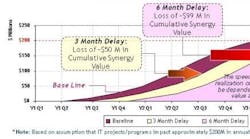After slowing in 2009, merger and acquisition (M&A) activity appears to be gaining steam in the consumer packaged goods (CPG) industry as evidenced by Kraft Foods' acquisition of Cadbury and Sara Lee's sale of its Ambi Pur brand to Procter & Gamble. However, as companies undergo M&A integration, many are taking on major business transformation programs to better align technology, personnel and processes with the organizations' business goals.
Many of the largest CPG companies grew to their current size largely through acquisition; however, the nature of today's M&As differs from what has historically occurred in the industry. After years of running multiple brands and business units, a number of companies are now trying to integrate acquisitions while consolidating and transforming their current holding companies. This set of parallel activities drives up the complexity of every merger and requires top-notch program management and execution to fully reap the fruits of M&A synergies.
Another characteristic of recent years is that many CPG companies have moved toward leaner business and technology organizations. This can be a challenge when undertaking large merger or business transformation projects that require many staff hours to enable process consolidation and optimization projects.
To achieve synergies while driving business innovation in processes, products and services, CPG companies use an ecosystem of service providers. However, many companies do not have an enterprise program office to orchestrate and manage multiple service providers.
Despite the extra help from service providers, many companies struggle to fully implement large technology projects. Often, many projects are completed late or over budget. For those projects that are completed, only a handful delivers on the promised business value. This inhibits the company from delivering on commitments made to its shareholders as part of its overall business transformation strategy.
The following figure illustrates a synergy savings model for a CPG company and the effects a three- and six-month delay would have on its business. Such delays would jeopardize the company's three-year project completion goal and cost the company tens of millions of dollars in lost savings.
Figure 1: Sample cumulative synergy savings model and the potential effects of delays in enabling it (source: HP)
In analyzing integration program delays at CPG companies, a number of common causes emerge. First, a delayed roll-out of an enterprise governance model is one of the leading factors for delay. This is often attributed to a lack of a program management office to take charge of the integration efforts. Other inhibitors include a lack of resources that can focus both on operations and transformation initiatives, multiple vendor procurement cycles, and ineffective vendor integration. Additionally, slow decision-making processes and insufficient communication between business and technology leaders can result in the early demise of an integration schedule.
An enterprise program management office that includes both business and technology leaders can help guide companies through combined M&A and transformation programs. This ensures proper alignment between the two groups. The enterprise program management office can also provide the standardized methodologies, tools, techniques and best practices needed to support complex project management. Efficient and effective business performance is often driven by full-stack integrated solutions that include business process innovation, applications, infrastructure and the management of organizational change.
Additionally, organizations must be able to handle multi-vendor environments. Multi-vendor governance enables companies to seamlessly orchestrate the work of various service providers and internal organizations, and deliver measurable business value. The following figure provides an overview of what a multi-vendor enterprise program management framework might look like for a large-scale M&A integration and business transformation program.
Figure 2: Multi-vendor enterprise program management framework (source: HP)
Companies that require temporary help to supplement staff capabilities or need help establishing a governance strategy often leverage a strategic provider that takes the role of a multi-vendor integrator to create, staff and manage the environments. Using a multi-vendor integrator, sometimes called a prime contractor, does not strip CPG companies of control. The company is still in the driver's seat and ultimately decides what projects to outsource, which vendors are chosen, and what the overall vendor contract strategy will be.
Prime contractors can serve a variety of functions such as unifying service provider management, delivering transparent communication to all parties, and even helping optimize the number and types of vendors providing services. Service providers in this role are also charged with aligning, as well as integrating, business, technology and outsourcing strategies. Other responsibilities include managing the risk profile of the program and enabling near real-time visibility to program performance (business value) through the use of a portal or command center.
Companies should choose a prime contractor based on the supplier's track record of creating and managing successful multi-vendor environments. A good prime contractor must also be able to objectively recognize its' own strengths and faults.
Although there is no standard approach for implementing and managing a multi-vendor governance strategy, successful programs tend to share a number of key characteristics:
- A strong enterprise program management framework and office (PMO).
- The implementation of a supplier portfolio strategy.
- The fostering of competition, but not to the point of distraction.
- Vendors that can handle new levels of complexity.
- Clear delineation of roles and responsibilities.
- Common languages, processes, standards, and tools.
- Open, honest business relationships between vendors.
- Performance measurement tools that are in place from the start.
- A unified billing approach.
- The focused implementation of an organizational change management strategy and tools.
Armed with these factors for success and support from business executives, program office frameworks can address the complexities of business transformation projects and help optimize the costs associated with a multi-vendor approach. They can also provide the underpinnings for a successful integration that achieves forecasted synergies by their due date.
Will Ruiz is managing director for the consumer industries consulting and solutioning practice at HP Enterprise Services.



